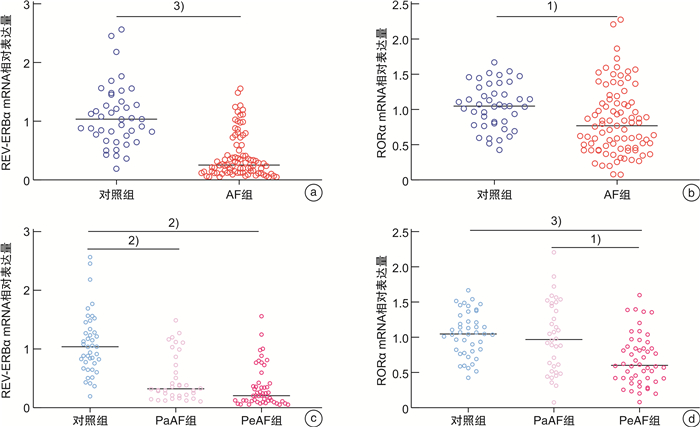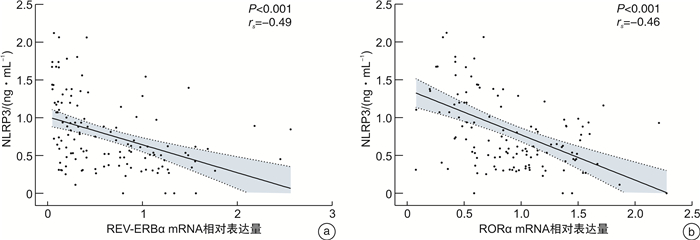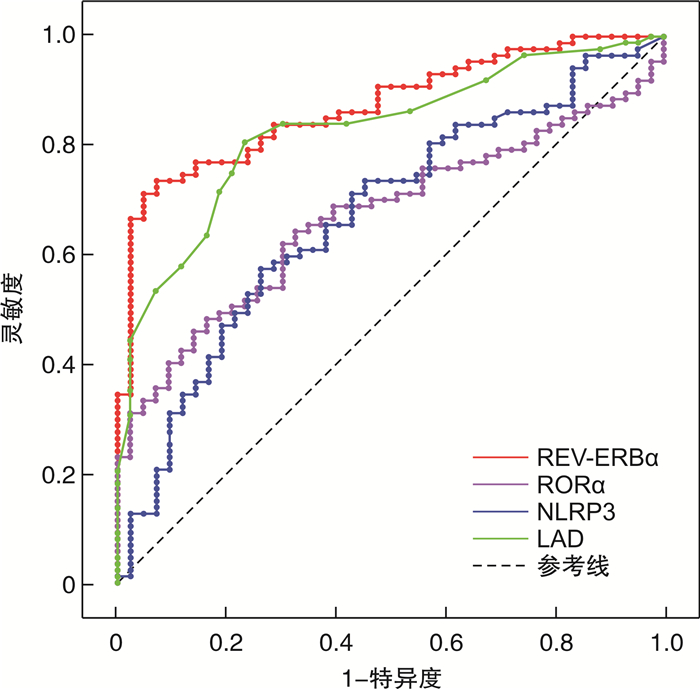Expression and clinical significance of clock genes REV-ERBα and RORα in patients with atrial fibrillation
-
摘要: 目的 研究时钟基因REV-ERBα、RORα在心房颤动(atrial fibrillation,AF)患者中的表达并探索其基于炎症调控途径参与AF发生发展的可能机制及相关临床价值。方法 选取2022年4—10月在扬州大学附属医院及江苏省苏北人民医院住院诊断为AF的患者88例,其中阵发性心房颤动(paroxysmal atrial fibrillation,PaAF)组37例,持续性心房颤动(persistent atrial fibrillation,PeAF)组51例,另选择同期体检中心体检的健康者43例作为对照组。采用qRT-PCR法检测外周血时钟基因REV-ERBα、RORα mRNA的表达,采用ELISA法检测血浆中炎症小体NLRP3蛋白的表达。比较3组患者的一般资料和实验室生化指标,采用Spearman进行相关性分析,有序多分类logistic回归分析AF的影响因素,受试者工作特征(receiver operating characteristic,ROC)曲线评估REV-ERBα、RORα、NLRP3、左房直径(left atrial diameter,LAD)4个指标对AF的辅助诊断效能。结果 REV-ERBα在PaAF组和PeAF组外周血中水平明显低于对照组(P < 0.01),在PaAF组与PeAF组之间无显著差异;RORα在PeAF组的水平明显低于对照组和PaAF组(P < 0.01),在PaAF组与对照组之间无显著差异;NLRP3和LAD随着AF的发展明显升高(P < 0.01);REV-ERBα、RORα与NLRP3及LAD在AF患者中呈负相关,NLRP3与LAD呈正相关;有序多分类logistic回归分析REV-ERBα、NLRP3、LAD为AF发生发展的影响因素,ROC曲线分析结果示REV-ERBα、RORα、NLRP3、LAD对AF的发生均具有一定的预测价值。结论 在AF患者外周血中REV-ERBα、RORα表达降低,NLRP3表达增高,REV-ERBα、RORα可能通过炎症及心房重构机制参与AF的发生发展并对AF的发生具有预测价值。Abstract: Objective To investigate the expression of clock genes REV-ERBα and RORα in patients with atrial fibrillation(AF), and to explore the possible mechanism and related clinical value of their involvement in the occurrence and development of AF based on inflammatory regulatory pathways.Methods A total of 88 patients diagnosed with AF hospitalized in the Affiliated Hospital of Yangzhou University and Jiangsu Subei People's Hospital from April 2022 to October 2022 were selected, 37 patients in the paroxysmal atrial fibrillation (PaAF)group and 51 cases in persistent atrial fibrillation (PeAF)group. In addition, 43 healthy subjects were selected as the control group from the physical examination center during the same period. The mRNA expression of REV-ERBα and RORα was detected by qRT-PCR. The expression of NLRP3 protein in plasma was detected by ELISA. The general information and laboratory test indexes of the three groups were compared, Spearman was used for correlation analysis. Receiver operating characteristic (ROC) curve was used to evaluate the auxiliary diagnostic efficacy of REV ERBα, RORα, NLRP3 and left atrial diameter (LAD) in AF.Results The level of REV-ERBα in PaAF and PeAF groups was significantly lower than that of control group (P < 0.01), but there was no significant difference between PaAF and PeAF groups. The level of RORα in PeAF group was significantly lower than that in control group and PaAF group (P < 0.01), but there was no significant difference between PeAF group and control group. NLRP3 and LAD increased significantly with the development of AF (P < 0.01). REV-ERBα and Rorα were negatively correlated with NLRP3 and LAD in AF patients, while NLRP3 was positively correlated with LAD. Multivariate Logistic regression analysis showed that REV-ERBα, NLRP3 and LAD were the influencing factors for the occurrence and development of AF. ROC curve analysis results showed that REV-ERBα, RORα, NLRP3 and LAD had certain predictive value for the occurrence of AF.Conclusion In the peripheral blood of patients with atrial fibrillation, the expression of REV-ERBα and RORα is decreased, while the expression of NLRP3 is increased. REV-ERBα and RORα may be involved in the occurrence and development of AF through inflammation and atrial remodeling mechanism, and have predictive value for the occurrence of AF.
-
Key words:
- atrial fibrillation /
- circadian rhythm /
- REV-ERBα /
- RORα /
- NLRP3 /
- left atrial diameter
-

-
表 1 引物序列
Table 1. Primer sequence
基因 上游(5′-3′序列) 下游(5′-3′序列) GAPDH GGAGCGAGATCCCTCCAAAAT GGCTGTTGTCATACTTCTCATGG REV-ERBα GCAAGGGCTTTTTCCGTCG GCGGACGATGGAGCAATTCT RORα ACTCCTGTCCTCGTCAGAAGA CATCCCTACGGCAAGGCATTT 表 2 3组患者一般资料和实验室检查指标比较
Table 2. General data and laborator yexamination indexes
例(%), X±S, M(P25, P75) 项目 对照组(43例) PaAF组(37例) PeAF组(51例) F/χ2/H P值 年龄/岁 63.00±10.37 68.60±12.381) 72.32±7.461) 10.093 < 0.001 性别(男/女) 23/20 17/20 29/22 1.042 0.594 BMI/(kg·m-2) 24.99±3.34 25.10±3.25 24.46±3.40 0.491 0.555 吸烟 6(14.0) 7(18.9) 9(17.6) 0.394 0.821 饮酒 6(14.0) 5(13.5) 8(15.7) 0.077 0.962 高血压病 23(53.5) 21(56.8) 36(70.6) 3.273 0.195 糖尿病 8(18.6) 9(24.3) 9(17.6) 0.663 0.781 冠心病 16(37.2) 20(54.1)1) 33(64.7)1) 7.115 0.029 慢性心力衰竭 2(4.7) 11(29.7)1) 32(62.7)1)2) 36.523 < 0.001 LAD/mm 33.21±3.75 36.50±4.501) 43.90±5.991)2) 41.914 < 0.001 空腹血糖/(mmol·L-1) 5.20(4.79,5.86) 5.25(4.76,6.48) 4.8(4.31,5.57) 3.456 0.178 尿酸/(μmol·L-1) 354.22±83.83 356.70±121.65 399.53±130.36 3.238 0.980 丙氨酸/(U·L-1) 23.00(18.00,30.00) 21.00(17.00,30.00) 22.00 (16.95,33.00) 0.686 0.709 天冬氨酸/(U·L-1) 27.16±6.20 27.06±8.86 30.32±9.90 3.655 0.161 TC/(mmol·L-1) 3.57±0.68 3.95±0.82 3.77±0.92 2.183 0.117 TG/(mmol·L-1) 1.47(1.12,1.91) 1.64(1.33,3.09) 1.54(1.14,2.35) 4.031 0.133 LDL/(mmol·L-1) 1.74±0.63 2.09±0.64 2.08±0.76 3.595 0.050 HDL/(mmol·L-1) 1.07±0.21 1.14±0.29 1.05±0.24 1.506 0.226 REV-ERBα 1.04(0.75,1.45) 0.32(0.20,0.93)1) 0.20(0.11,0.41)1) 51.756 < 0.001 RORα 1.05±0.32 1.01±0.51 0.72±0.421)2) 19.809 < 0.001 NLRP3/(ng·mL-1) 0.51(0.33,0.75) 0.62(0.34,0.93) 1.07(0.55,1.44)1)2) 20.134 < 0.001 与对照组比较,1)P < 0.05;与PaAF组比较,2)P < 0.05。 表 3 有序多分类logistic回归的变量赋值
Table 3. Variableassignment
因素 赋值 AF 对照=0、PaAF=1、PeAF=2 冠心病 无=0、有=1 心力衰竭 无=0、有=1 表 4 AF影响因素的有序多分类logistic回归分析
Table 4. Influencing factors of atrial fibrillation analyzed by logistic regression model
因素 B SE Wald P值 95%CI 下限 上限 年龄 0.043 0.022 3.686 0.055 -0.001 0.086 冠心病 0.311 0.462 0.453 0.501 -0.594 1.215 慢性心力衰竭 -1.162 0.532 4.780 0.029 -2.204 -0.120 REV-ERBα -2.176 0.573 14.426 < 0.001 -3.298 -1.053 RORα -0.346 0.532 0.424 0.515 -1.389 0.696 NLRP3 0.123 0.059 4.355 0.037 0.007 0.238 LAD 0.159 0.044 12.995 < 0.001 0.072 0.245 表 5 REV-ERBα、RORα、NLRP3、LAD对AF的预测价值
Table 5. Predictive value of REV-ERBα, RORα, NLRP3 and leftatrial diameterfor atrial fibrillation
项目 AUC(95%CI) cut off值 灵敏度 特异度 P值 REV-ERBα 0.8722(0.8124~0.9320) 0.6650 0.7126 0.9524 < 0.0001 RORα 0.6709(0.5800~0.7619) 0.3203 0.4598 0.8605 0.0016 NLRP3 0.6751(0.5774~0.7728) 0.3140 0.5698 0.7442 0.0012 LAD 0.8290(0.7582~0.8998) 0.5740 0.8068 0.7674 < 0.0001 -
[1] 冯光玲, 郅强, 李欣欣. 心房颤动发病机制的基础研究进展[J]. 世界科学技术-中医药现代化, 2022, 24(6): 2255-2263. https://www.cnki.com.cn/Article/CJFDTOTAL-SJKX202206011.htm
[2] Kim J, Wang W, Norby FL, et al. Diurnal circadian variations in paroxysmal atrial fibrillation: The atherosclerosis risk in communities(ARIC)study[J]. J Electrocardiol, 2020, 63: 98-103. doi: 10.1016/j.jelectrocard.2020.10.013
[3] Man K, Loudon A, Chawla A. Immunity around the clock[J]. Science, 2016, 354(6315): 999-1003. doi: 10.1126/science.aah4966
[4] Rabinovich-Nikitin I, Rasouli M, Reitz CJ, et al. Mitochondrial autophagy and cell survival is regulated by the circadian Clock gene in cardiac myocytes during ischemic stress[J]. Autophagy, 2021, 17(11): 3794-3812. doi: 10.1080/15548627.2021.1938913
[5] 苏洁, 成扶雨, 卜军. 生物钟核受体RORα和REV-ERBα在血管病理生理中的作用[J]. 药学进展, 2020, 44(12): 906-916. https://www.cnki.com.cn/Article/CJFDTOTAL-YXJZ202012008.htm
[6] Pourcet B, Duez H. Circadian Control of Inflammasome Pathways: Implications for Circadian Medicine[J]. Front Immunol, 2020, 11: 1630. doi: 10.3389/fimmu.2020.01630
[7] Hindricks G, Potpara T, Dagres N, et al. Corrigendum to: 2020 ESC Guidelines for the diagnosis and management of atrial fibrillation developed in collaboration with the European Association for Cardio-Thoracic Surgery(EACTS): The Task Force for the diagnosis and management of atrial fibrillation of the European Society of Cardiology(ESC)Developed with the special contribution of the European Heart Rhythm Association(EHRA)of the ESC[J]. Eur Heart J, 2021, 42(40): 4194. doi: 10.1093/eurheartj/ehab648
[8] Ikeda R, Tsuchiya Y, Koike N, et al. REV-ERBα and REV-ERBβ function as key factors regulating Mammalian Circadian Output[J]. Sci Rep, 2019, 9(1): 10171. doi: 10.1038/s41598-019-46656-0
[9] Lu D, Zhao M, Chen M, et al. Circadian Clock-Controlled Drug Metabolism: Implications for Chronotherapeutics[J]. Drug Metab Dispos, 2020, 48(5): 395-406. doi: 10.1124/dmd.120.090472
[10] Zhao Y, Lu X, Wan F, et al. Disruption of Circadian Rhythms by Shift Work Exacerbates Reperfusion Injury in Myocardial Infarction[J]. J Am Coll Cardiol, 2022, 79(21): 2097-2115. doi: 10.1016/j.jacc.2022.03.370
[11] Ding S, Lin N, Sheng X, et al. Melatonin stabilizes rupture-prone vulnerable plaques via regulating macrophage polarization in a nuclear circadian receptor RORα-dependent manner[J]. J Pineal Res, 2019, 67(2): e12581.
[12] Chen YL, Chuang JH, Wang HT, et al. Altered Expression of Circadian Clock Genes in Patients with Atrial Fibrillation Is Associated with Atrial High-Rate Episodes and Left Atrial Remodeling[J]. Diagnostics(Basel), 2021, 11(1): 90.
[13] 王逸萌, 王巍, 田艳丰. NLRP3炎症小体与心房颤动关系的研究进展[J]. 中华心血管病杂志, 2021, 49(12): 1276-1280. doi: 10.3760/cma.j.cn112148-20210606-00477
[14] Yao C, Veleva T, Scott L Jr, et al. Enhanced Cardiomyocyte NLRP3 Inflammasome Signaling Promotes Atrial Fibrillation[J]. Circulation, 2018, 138(20): 2227-2242. doi: 10.1161/CIRCULATIONAHA.118.035202
[15] 杨敏, 肖模超. 心房颤动患者左心房形态结构及功能与血栓形成关系的研究进展[J]. 临床心血管病杂志, 2023, 39(2): 103-107. https://lcxxg.whuhzzs.com/article/doi/10.13201/j.issn.1001-1439.2023.02.006
[16] Vaziri SM, Larson MG, Benjamin EJ, et al. Echocardiographic predictors of nonrheumatic atrial fibrillation. The Framingham Heart Study[J]. Circulation, 1994, 89(2): 724-730. doi: 10.1161/01.CIR.89.2.724
[17] Pourcet B, Zecchin M, Ferri L, et al. Nuclear Receptor Subfamily 1 Group D Member 1 Regulates Circadian Activity of NLRP3 Inflammasome to Reduce the Severity of Fulminant Hepatitis in Mice[J]. Gastroenterology, 2018, 154(5): 1449-1464. e20. doi: 10.1053/j.gastro.2017.12.019
[18] Kou L, Chi X, Sun Y, et al. The circadian clock protein Rev-erbα provides neuroprotection and attenuates neuroinflammation against Parkinson's disease via the microglial NLRP3 inflammasome[J]. J Neuroinflammation, 2022, 19(1): 133. doi: 10.1186/s12974-022-02494-y
[19] Wang S, Lin Y, Yuan X, et al. REV-ERBα integrates colon clock with experimental colitis through regulation of NF-κB/NLRP3 axis[J]. Nat Commun, 2018, 9(1): 4246. doi: 10.1038/s41467-018-06568-5
[20] Wu Z, Liao F, Luo G, et al. NR1D1 Deletion Induces Rupture-Prone Vulnerable Plaques by Regulating Macrophage Pyroptosis via the NF-κB/NLRP3 Inflammasome Pathway[J]. Oxid Med Cell Longev, 2021, 2021: 5217572.
[21] García JA, Volt H, Venegas C, et al. Disruption of the NF-κB/NLRP3 connection by melatonin requires retinoid-related orphan receptor-α and blocks the septic response in mice[J]. FASEB J, 2015, 29(9): 3863-3875. doi: 10.1096/fj.15-273656
-





 下载:
下载:



